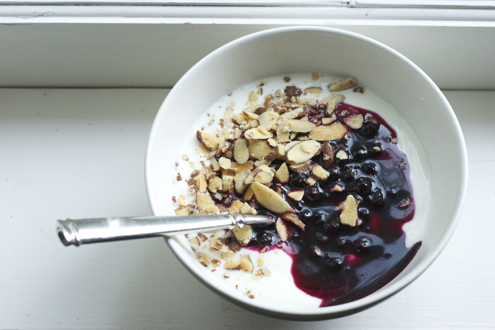What does it take to put on a sit down, linen-napkined, starched-damask-table-clothed, polished silvered, Norman Rockwellian-style, Thanksgiving dinner? The sort of dinner at which there are little acorn shaped chocolate hazelnut truffles at every place, where candles glow in polished silver candelabra, and heavy cream-colored place cards perch over every plate. Imagine cooking a dinner like that for twenty five people. Every year. For ten years. What if you followed that dinner with a similarly scaled Christmas dinner just one month later? Sounds totally crazy, right?
Since we moved to Seattle nine years ago, I have never had to make Thanksgiving dinner, or Christmas dinner for that matter, thanks to my aunt, who lives just around the corner. Since I obviously like to cook, perhaps you are wondering why I don’t want to cook Thanksgiving dinner myself? I suppose, if anyone besides my very talented aunt were cooking, maybe I would have broken away from her big dinner and done my own. Sometimes I have thought about trying a sourdough, artichoke and prosciutto stuffing, or making brussels sprouts with chestnuts. But how could I? And miss her incredible menu and all the fun?! No way.
It goes like this: On Thanksgiving night, as soon as I walk in the door, my uncle hands me a flute of champagne. In the background, one of my brother-in-law’s CDs plays just loudly enough to hear. Some cousins are clustered on low couches around the fire, which is blazing and snapping with big oak logs. On the coffee table, my dad’s sister has placed the Braunschweiger pate with aspic. Braunschweiger pate with aspic might be considered odd in this day and age and even a little lowbrow, but it is traditional in our family and beloved by those who knew our Great-Aunt Frances, who, years ago, always used to bring it. Weirdly, my kids adore it and I have to stop them devouring all of it so that somebody else can have a little taste. In the kitchen, more cousins play yatzy and cribbage games at the table, keeping my aunt company. She should be very busy with dinner.
But my aunt looks as cool as a cucumber. Her kitchen is orderly and calm. How can this be? It’s as if, at the very last minute, she‘ll have to wave some magic foodie wand, and suddenly everything will appear on the buffet. Gleaming porcelain and glazed carrots. A wide platter of crisp little green beans with shallots or almonds. Deep pink sweet and sour cabbage. Hillocks of mashed potatoes with several lakes of melted butter glistening in the valleys. Clearly she’s been up to something. You have to actually roast a turkey if you want the house filled with that bronzy, burnished scent. It’s astonishing. How does her kitchen stay so clean? How come everything is done at exactly six thirty? There are mountains of deliciousness to account for! How does she do it?!
I think I’m about to find out.
This year, for the first time in a long time, most of us cousins have dispersed for the holiday. And so, my aunt is taking a break from Thanksgiving. I have decided it’s my turn to host a slightly smaller version of the holiday myself. Besides the five in my immediate family, my neighbors are coming to dinner. So are my aunt and uncle (who usually host), and cousin Steve. Hosting Thanksgiving for my aunt feels a little like hosting the queen of England (or maybe the Queen of Thanksgiving). This will take some planning. A lot of planning probably. I am aiming for a perfect Thanksgiving like my aunt’s, although in miniature, as my dining room seats just ten in a pinch. And why not? There is nothing intrinsically complicated about Thanksgiving dinner. What you need is a good plan of attack.
Here’s mine:
In the week before Thanksgiving week:
- Make turkey stock and freeze it.
- Iron all the napkins (now is the time to make sure you have enough!) and the best tablecloth.
- Figure out the candle situation. Do you have any? Are they the right color? Do you want tapers, tea lights or pillars? All three?
- Figure out what wines you will serve. Have both red and white on hand and count on a bottle per person. (although we all hope you have some left over)
- Have a non-alcoholic beverage for kids and those who don’t wish to imbibe. We have the obvious sparkling apple juice and bottled water.
- Buy the place cards and candy favors if you like that sort of thing. My kids would be crushed if I forgot.
- Figure out where you will serve the food – in my aunts house, the kitchen is so huge and she keeps it so tidy, she can serve from the enormous kitchen island. She displays the dessert on the buffet. I think my kitchen will be something of a disaster and I am clearing off the side board this afternoon. The kid art and clutter that typically inhabits that space will take off for the basement temporarily.
- Are there enough serving dishes in the house? Take an inventory. As you plan for all the serving pieces, imagine if they will all fit on the table or if you will need a serving station, either the sideboard in the dining room or a table in the kitchen. Look for:
- a platter for the turkey – Mine won’t have to be too big as I will be carving in the kitchen and not at the table (I’m not good at carving and I don’t wish to have some sloppy turkey dismemberment in front of my whole family) Slices of turkey don’t take up as much room as the whole bird.
- A gravy boat, a small ladle and a little plate to catch the drips
- a bowl or two for cranberry sauce – one for each end of the table (I have a couple of plain white cafe au lait bowls that will suffice) with two little serving spoons
- a medium bowl for the stuffing
- a large baking dish that can go from oven to table for the dressing – white stoneware is what I have
- a large bowl for mashed potatoes
- a medium bowl for the red cabbage
- 2 medium sized bowls for the glazed carrots and green beans
- 5 (at least) serving spoons and one nice fork for the sides and turkey
- enough plates, silverware, water glasses, wine glasses, dessert plates and coffee cups
- you may also like cocktail or champagne glasses (I have made cranberry shrub – which I will mix with ginger syrup, gin and a splash of soda – I really hope it will be good!)
- Make the cornbread if you are serving cornbread dressing. You can freeze it then pull it out the day before Thanksgiving so it can dry out a little.
- Make and refrigerate a pie crust. See here for my favorite method.
- If you are farming out any part of your dinner to your guests, make sure they know what to bring now, if they don’t know already. Appetizers and dessert make the most sense as side dishes would get cold if brought from home and you don’t want anyone messing around in the kitchen when you are trying to pull it all together at the last minute (at least that’s what my aunt says!)
- Make the cranberry sauce








































